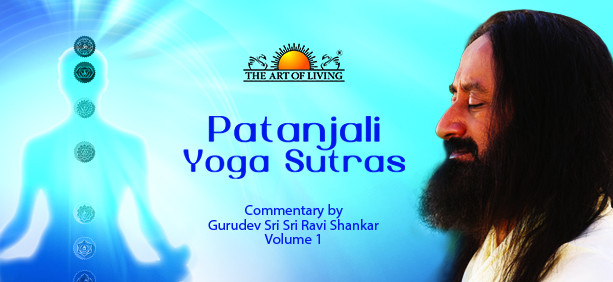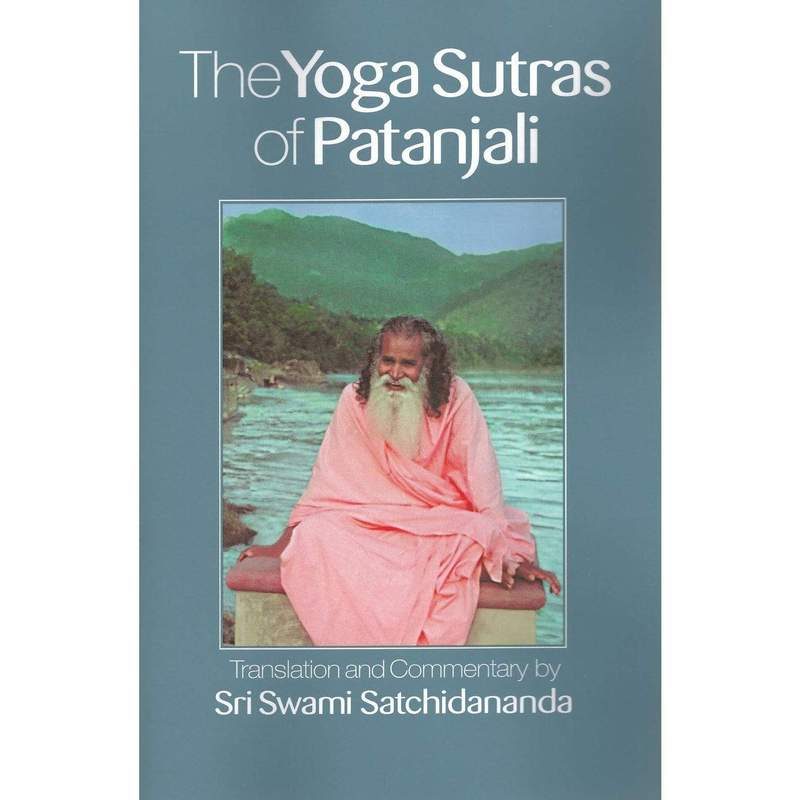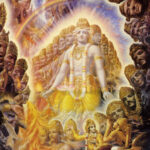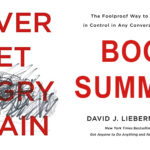
Patanjali Yoga Sutras – Summary of Commentary by Sri Sri Ravi Shankar
Detailed videos by The Sanskrit Channel at the bottom of the post.
Free PDF version of the full texts in Sanskrit, English and more – Yoga Sutras of Patanjali Interpretive Translation Presented by Swami Jnaneshvara Bharati www.SwamiJ.com
Summary:
Chapter 1: Concentration (Samadhi Pada)
1.1 atha yoga anushasanam – Now, the teachings of yoga
1.2 yogash chitta vritti nirodhah – Yoga is to still the patterning of consciousness
– The first thing Patanjali starts with is ‘Now, we’ll begin…’. So after we’ve finished with the preperation and we are ready, now we can begin to look at the rules of yoga.
– These are the disciplines we put on ourselves. Disciplines will start out hard but will bring us joy and freedom. Like discipline to brush or not eat too much sugar. True discipline will give you joy.
– Satvic happiness starts hard but leads to joy. Rajasic happiness starts out with joy but ends up as misery. Tamsic does not give you any happiness, it appears to be happiness but it gives you misery from begining to end.
1.3 tada drashtuh svarupe avasthanam – Then, pure awareness can abide in its very nature
1.4 vritti sarupyam itaratra – Otherwise, awareness takes itself to be the patterns of consciousness
– This discipline will integrate your whole being. Uniting all the loose ends of your existence.
– Children are totally immersed in a movie or totally engaged in something.
– Retrieve your mind from the 5 senses and go into your heart. Abide in the nature of the seer. This is yoga.
1.5 vrittayah pancatayah klishta aklishta – There are five types of patterns, including both hurtful and benign
1.6 pramana viparyaya vikalpa nidra smritayah – They are 1) right perception, 2) misperception, 3) conceptualization, 4) deep sleep, and 5) remembering
1.7 pratyaksha anumana agamah pramanani – Of these five, there are three ways of gaining correct knowledge (pramana): 1) perception, 2) inference and 3) testimony or verbal communication from others who have knowledge.
– 5 modes of consciousness arise:
a. Pramana: your mind wants proof that you are in Switzerland right now by looking at the mountains. Wanting proof is the main activity of the mind, you constantly want proof. Yoga is dropping it and abiding in self.
b. Vipryaya: misperception or wrong understanding. You impose wrong ideas on others as you have placed them in a box.
c. Vikalpa: Hallicunation, fantasy. Unfounded and baseless ideas. They could be either of playful fantasy or baseless fears.
d. Nidra: Sleep
e. Smriti: Remembering.
None of these states are a state of meditation.
1.12 abhyasa vairagyabhyam tat nirodhah – Both practice and non-reaction are required to still the patterning of consciousness
1.13 tatra sthitau yatnah abhyasa – Practice is the sustained effort to rest in that stillness
– Abide in the seer, be in this moment, now now now now. The practice is constant, again and again. This is abhyasa.
1.14 sah tu dirgha kala nairantaira satkara asevitah dridha bhumih – And this practice becomes firmly rooted when it is cultivated skillfully and continuously for a long time
– To be established in it will take a long time without a gap and with honour and respect.
– Anything of value take some time to culture.
– Over time you start losing the attentiveness and honour. It will not have the same effect because you’ve lost that alertness towards the practice.
– Honour is being in the moment with a hint of gratefulness. Honouring the mountain or with someone you look up to. This is what the asanas and pranayams are.
1.15 drista anushravika vishaya vitrishnasya vashikara sanjna vairagyam – As for non-reaction, one can recognize that it has been fully achieved when no attachment arises in regard to anything at all, whether perceived directly or learned
– Your mind is distracted by the senses. The craving to fulfil the senses will take you away from the moment. Your senses want more and more.
– Vairaghya is coming back to the source and not being moved by the external. Detachment, indifference.
– Don’t be on a mission to destroy the desires because that is another desire.
– Craving for happiness will make you unhappy. When you don’t care for happiness you attain liberation and when you don’t care for liberation you attain love (param vairaghya). Then yoga happens.
– Free yourself from the feverishness that is gripping your mind. All your sources of happiness have not lasted, they have nothing in them. How long can you feed your senses?
– Honour your senses, don’t blame them or the temptations and cravings.
1.16 tat param purusha khyateh guna vaitrshnyam – When the ultimate level of non-reaction has been reached, pure awareness can clearly see itself as independent from the fundamental qualities of nature
– When you are totally centred, nothing can touch you.
– 3 gunas come in waves. Satva, rajas, tamas. Good, bad and ugly come in cycles and one who is centred will go through it as a silent witness.
– Yoga itself means skill. Skill to move on, skill to love in spite of things.
– Your mind is actually split when you think of the future or past.
– Dispassion gives you joy that nothing else can give, it doesn’t take away joy from you. It puts you 100% in the moment.
– Diogenes was taken to be sold as a slave but the people around him looked like the slaves.
1.17 vitarka vichara ananda asmita rupa anugamat samprajnatah – At first, the stilling process is accompanied by four kinds of cognition: 1) analytical thinking, 2) insight, 3) bliss, or 4) feeling like a self
– Explains the 3 logics – read more here.
– Vitarka: There is an obvious irrefutable logic like when you are in a movie and so engrossed but when it’s finished you know that it’s over. The show is over.
– Vichara: there are 2 thoughts, 1) which come and go and 2) some that disturb you or move your mind.
– Ananda: When you’re in ecstasy like after a meditation. You are in bliss.
– Asmita: You just know that ‘I am’.
1.18 virama pratyaya abhyasa purvah samskara shesha anyah – Later, after one practices steadily to bring all thought to a standstill, these four kinds of cognition fall away, leaving only a store of latent impressions in the depth memory
1.19 bhava pratyayah videha prakriti layanam – Once the body is gone, and these latent impressions are dissolved in nature, they are inclined to be reborn
– By reposing in self. Not sleep rest but consciously resting. You allow the rest to happen. Sleep is putting you to rest, meditation is you resting on your own.
– In this stage you are affecting subtle layers of creation from people in the past and future. You are in a way cleaning the energy on so many levels.
– When you are watching the water and you become the water – prakriti laya samadhi.
– When you are worried sit by flowing water and notice what happens to your mind. The movement of the water changes the prana in the system.
1.20 shraddha virya smriti samadhi prajna purvakah itaresham – For all others, faith, energy, mindfulness, integration, and wisdom form the path to realization (Guruji says this is the most important sutra)
– Shraddha: Faith makes you so solid, it brings totality and pulls all the loose ends together. Doubts unravels you. Consilidation of energy is faith.
– Virya: force and vitality, total courage. VALOUR, come on! it is a defence against fear and when it comes to it’s peak, there is a joy in it and will take you to a state of meditation.
– Smriti: Memory of a beautiful state of mind will make you relive it.
Amazon #ads
1.21 tivra samvega asannah – For those who seek liberation wholeheartedly, realization is near
1.22 mridu madhya adhimatra tatah api visheshah – How near depends on whether the practice is mild, moderate, or intense
1.23 ishvara pranidhana va – Realization may also come if one is oriented toward the ideal of pure awareness, Isvara
– Give first priority to spiritual gain.
– It’s very easy for someone who gives it frist preference.
– Your level of practice will determine it.
1.24 klesha karma vipaka ashayaih aparamristah purusha-vishesha ishvara – Isvara is a distinct, incorruptible form of pure awareness, utterly independent of cause and effect, and lacking any store of latent impressions.
– Everything is love, it’s inbuilt in consciousness.
– 5 types of suffering (klesha):
a) Avidya – Ignorance, there is restlessness, misery. Giving importance to things that are not worth. Thinking everchaning to be permanent.
b) Asmita – The feeling of me me, I I. All are fools only I am intelligent.
c) Ragha – Craving.
d) Dwesha – Aversion, hatered.
e) Abhinivesha – Fear.
– The core of your existence is free from all this. When the kleshas are elimitnated, god in you is manifested. The divinity comes out. And also free of karma.
– 4 types of karma:
a) Karma that gives merit. Good karma.
b) Karma that gives you demerits. Bad karma.
c) Both good and bad.
d) Deviod of merit and demerit. Like going for a walk or cleaning the house.
– The divine is not out there somewhere in the sky, it’s inside you. All worship is the mind to it’s own being. The boundry to the center. When this happens it becomes infinite.
– Your mind starts dissolving when it’s free from suffering, karma and vipaka.
1.25 tatra niratishayam sarvajna bijam – Its independence makes this awareness an incomparable source of omniscience
1.26 purvesham api guruh kalena anavachchhedat – Existing beyond time, Isvara was also the ideal of the ancients
– The guru priciple is the same because there is no breakage of time. It’s said in the Bible (John 8:49-52 and Bhagwad Gita 4.06).
– The seed of all knowing is present in a special way.
– It’s like a dictionary, you can find what you want but you don’t need to know all the words. The same way you can know about billions and trillions of living beings. You know you have thousands of strands on your head but you don’t know each one. Yet if someone pulls one strand you are fully aware.
1.27 tasya vachakah pranavah – Isvara is represented by a sound, om
1.28 tat japah tat artha bhavanam – Through repetition its meaning becomes clear (another important sutra)
1.29 tatah pratyak chetana adhigamah api antaraya abhavash cha – Then, interiorization develops and obstacles fall away
– Om is the nearest sound that can connect to this eternal consciousness.
– Japah means a sound that can remind you of that state or feeling.
– Witness consciousness dawns and your mind gets totally transformed.
1.30 vyadhi styana samshaya pramada alasya avirati bhranti-darshana alabdhabhumikatva anavasthitatva chitta vikshepa te antarayah – Sickness, apathy, doubt, carelessness, laziness, hedonism, delusion, lack of progress, and inconstancy are all distractions which, by stirring up consciousness, act as barriers to stillness
– 9 obstacles:
a) vyadhi: physical illness
b) styana: mental illness, retardation, disability, apathy
c) samshaya: doubt. 3 types – 1) Self doubt, 2) doubt about the technique 3) doubt about the teacher. You don’t doubt negativity, oh am I depressed.
d) pramada: carelessness, negligence. Not doing something that you should or doing something that is not good for you.
e) alasya: laziness, sloth.
f) avirati: the obsession to fulfil physical desires like gluttony, promiscuity, etc.
g) bhranti-darshana: hallucination, false conception. Residues of your hatred or desires will give you dreams that will make you feel these are prophecies or similar.
h) alabdhabhumikatva: non-attainment, not progressing, stuck. (Read more on feeling stuck here)
i) anavasthitatva: obstacles or not getting stabilised in any state.
1.31 duhkha daurmanasya angam-ejayatva shvasa prashvasah vikshepa sahabhuva – When they do, one may experience distress, depression, or the inability to maintain the steadiness of posture or breathing
4 Signs or side-effects of obstacles:
– duhkha = pain (mental or physical. Sadness and bitterness comes along with this.
– daurmanasya = bitterness, despair, dejection, frustration, depression, anguish.
– angam-ejayatva = shakiness, unsteadiness, movement, lack of coordination.
– shvasa prashvasah = uncomfortable or irregular breathing.
1.32 – tat pratisedha artham eka tattva abhyasah – One can subdue these distractions by working with any one of the following principles of practice
– To over come these you need to just keep doing one thing. One pointed attention in one thing. Boredom will come and the restlessness will take you to a peak where you reach a clarity. More on The One Thing here.
– The divided mind is misery, the one-pointed mind is joy.
1.33 – maitri karuna mudita upekshanam sukha duhka punya apunya vishayanam bhavanatah chitta prasadanam – Consciousness settles as one radiates friendliness, compassion, delight, and equanimity toward all things, whether pleasant or painful, good or bad
– Another way is to be friendly towards people who are happy otherwise you feel jealousy. Feel happy with people who do good things.
– If you are friendly with unhappy people then you become miserable. Have compassion or sympathy for them but don’t become unhappy too. Don’t pity people who are suffering.
– Ignore people who are doing sinful or bad things. If you can educate them and then ignore them.
1.34 – prachchhardana vidharanabhyam va pranayama – Or by pausing after breath flows in or out
– One more way is to regulate your breath by breaking it into rhythms (the secret of Sudarshan Kriya Yoga)
1.35 – vishayavati va pravritti utpanna manasah sthiti nibandhani – Or by steadily observing as new sensations materialize
1.36 – vishoka va jyotishmati – Or when experiencing thoughts that are luminous and free of sorrow
1.37 – vita raga vishayam va chittam – Or by focusing on things that do not inspire attachment
1.38 – svapna nidra jnana alambanam va – Or by reflecting on insights culled from sleep and dreaming
1.39 – yatha abhimata dhyanat va – Or through meditative absorption in any desired object
– If these don’t work then again try to focus on one of the senses. Close your eyes and you’ll shut part of the external world. Sing for a while. Through one of the senses, you can get to steady yourself.
– When you look at your mind the self-made sadness will disappear because it’s unfounded. Your mind is made of light and energy, you are not the matter.
– Think of someone who has overcome the cravings and your mind will assume the qualities. We usually tense up when you think of someone that makes you angry.
– Mind is like fire, feed it well and the candle of life will burn right. Your mind is like water, water becomes the shape of the cup so where you pour your mind will shape it. Mind is like air, it doesn’t have a location, it’s all-pervading.
– We sleep all our lives but we never meet our sleep. Ignorant people make a dream reality and enlightened see this reality as dreams. You are in 2 states of consciousness – sleep or dream. Daydreaming or night dream. When you awaken a rush of energy comes to you.
– 5 types of dreams which most people can’t differentiate:
a) Unfulfilled desires and fears come up. You wanted pizza and you dream of pizza.
b) Stressed released from past.
c) Intuitive dream, what might happen in future.
d) A mixture of all types of dreams.
e) The dream has nothing to do with you, it has to do with the place you are in.
– Finally, any method of meditation will help, stick to it don’t keep changing methods.
1.40 – parma-anu parama-mahattva antah asya vashikarah – One can become fully absorbed in any object, whether vast or infinitesimal
– From the smallest particle to the biggest, everything comes to work for you.
1.41 kshinna-vritti abhijatasya iva maneh grahitri grahana grahyeshu tat-stha tat-anjanata samapattih – When the modifications of mind have become weakened, the mind becomes like a transparent crystal, and thus can easily take on the qualities of whatever object observed, whether that object be the observer, the means of observing, or an object observed, in a process of engrossment called samapattih
– When the Earth shakes just for a few seconds it creates so many calamities. You can be at peace when nature is at peace. Meditation can happen when there is harmony in your senses. When the senses shake you get tired.
– The same eyes that give you light and knowledge also brings you troubles, it’s the greatest distraction of all the senses.
– The mind wants you to keep changing the radio station to find the best song and then the next best.
– When the senses become steady, even the shaky prana will be made steady. Don’t worry if prana is shaky, just know/observe/be with it. This will start centring you.
– Sabija samadhi: is one of the samadhis you experience when you lose yourself into what your focus is on. Like a child staring at things.
– Experiment by keeping your body and eyes steady, you’ll see that even your mind and breath will become steady.
– Samadhi is like freezing your mind, it stays fresh forever. It’s the secret of youthfulness, bubbling enthusiasm and renewal of life.
1.42 tatra shabda artha jnana vikalpah sankirna savitarka samapattih – So long as conceptual or linguistic knowledge pervades this transparency, it is called coalescence with thought
1.43 smriti pari-shuddhau svarupa-shunya iva artha-matra nirbhasa nirvitarka – At the next stage, called coalescence beyond thought, objects cease to be colored by memory; now formless, only their essential nature shines forth
– Though you are engaged in the activities of the senses, there is steadiness. The more anxious or nervous you are the more you stuff your food very fast.
– Thoughts come but it doesn’t distort the harmony in you.
– Nirvitarka samadhi: Another samadhi is where you just know that you are.
1.47 nirvichara vaisharadye adhyatma prasadah – In the lucidity of coalesced, reflection-free contemplation, the nature of the self becomes clear
1.48 ritambhara tatra prajna – The wisdom that arises in that lucidity is unerring
1.49 shruta anumana prajnabhyam anya-vishaya vishesha-arthatvat – Unlike insights acquired through inference or teachings, this wisdom has as its object the actual distinction between pure awareness and consciousness
1.50 tajjah samskarah anya samskara paribandhi – It generates latent impressions that prevent the activation of other impressions
1.51 tasya api nirodhe sarva nirodhat nirbijah samadhih – When even these cease to arise, and the patterning of consciousness is completely stilled, integration bears no further seeds
– More and more experience of thoughtless state of mind will bring the grace of the divine in life. Spiritual blossoming occurs the more you are hollow and empty.
– This knowledge is flawless and beyond time. Full of truth.
– It is different from the knowledge you’ve heard or guessed.
– The true knowledge will wipe out impressions of the past. It renews you and erases previous sanskaras. When you remember the past you feel like that was someone else.
– You don’t become lethargic, you don’t say god will it will happen. Patience and dynamism is the golden rule for the first chapter.
Chapter 2: Practices (Sadhana Pada)
2.1 tapah svadhyaya ishvara-pranidhana kriya-yogah – Yogic action has three components – discipline, self-study, and orientation toward the ideal of pure awareness
– Uniting with the mind, with time is yoga.
– There is nothing still in this creation, everything has activity. The intelligent person sees silence in activity and activity in silence. You can see this when you have skill in activity, and that is yoga.
– 3 parts to yoga
a) Tapah/tapas: acceptance/endurance. You feel tired in the place but you keep sitting because you have no choice. Willingly experiencing what is without grumbling.
b) Svadhyaya: self-study and observing what is happening in your body and mind and around you. Studying emotions.
c) Ishvara-pranidhana: Devotion to the divine.
3 kinds of Tapas
a) Bodily – keeping hygiene and lethargy out.
b) Speech – speaking in a way that it doesn’t hurt. Truth and pleasant truth. Often, speaking less makes you more charming.
c) Mind – Maintaining the pleasantness in the mind. Sensitivity to the surrounding.
5 kinds of fire
a) Bhutagni – To warm your home and heat your food. This physical fire is present in your body to some extent.
b) Kamagni – the fire of desire. Life continues on this planet because of it. We don’t allow it to rise up, as soon as the desire comes up you do something about. Promiscuous people finish it there and then, which is why they don’t have any real enthusiasm in life. Let it awaken and burn you up. Sex is the oldest sanskara, sex and food.
c) Jataragni – hunger and digestion. Important in Ayurveda. Even when you get a fever, it’s burning up to purify your body. Even before you feel hungry you keep stuffing yourself. These days more are dying of overeating. Let the fire of hunger grow and don’t suffocate it. Fasting is good to clean you of all toxins, it touches the deepest sanskara in you. But don’t overdo it. Don’t starve or suffocate this fire.
d) Badabagni – the fire of criticism. It keeps you moral in you. Too much of it can shut down your freedom. Doesn’t matter what people say, feelings change.
e) Premagni/Jnanagni – Fire of knowledge of love. The fire of love begins with an intense longing. It can only be experienced in human life. It moves from longing to blossoming of bliss.
When life moves through these fires, it comes out as gold. These days we don’t let the fires to come up. We get a fever and we take medicine to relieve the symptoms. We need to take action to attend to the root cause, not the symptoms.
For full text please see – https://www.arlingtoncenter.org/Sanskrit-English.pdf
or – http://swamij.com/pdf/yogasutrasinterpretive.pdf
Detailed Patanjali Yoga Sutras with Pictures – Chapter 1 – States of Meditativeness Chapter 2 – Eight Limbs of Yoga – Detailed Patanjali Yoga Sutras with Pictures Chapter 3 – Attainments Through Yogic Practice – Detailed Patanjali Yoga Sutras with Pictures Chapter 4 – The Ultimate State of Unity – Detailed Patanjali Yoga Sutras with PicturesAmazon #ads









